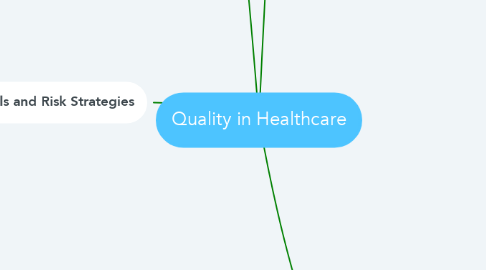
1. Global Issues around CQI and Safety
1.1. Attitudes and barriers to incident reporting: a collaborative hospital study
1.1.1. "Nurses had a greater awareness of and used the incident reporting system more than doctors"
1.1.2. "Almost a quarter of staff did not know how to access an incident form or what to do with it once completed, and over 40% of consultants and registrars had never completed a report"
1.1.3. "Only 42.0% of the staff surveyed believed that medication near misses should always be reported, indicating that literature emphasising the importance of reporting near misses is not translating to changes in attitude or clinical"
1.1.4. "Almost two thirds of respondents believed lack of feedback was the greatest deterrent to reporting"
2. Errors in Healthcare
2.1. Safety Culture
2.1.1. No Blame Culture
2.1.2. Just Culture
2.2. Errors
2.2.1. Impact of Errors
2.2.1.1. Affected Patient and Family
2.2.1.2. Secondary Victims
2.2.1.3. Healthcare System
2.2.2. Types of Errors
2.2.2.1. Error of Omission
2.2.2.2. Misuse
2.2.2.3. Errors of Commission
2.2.2.4. Communication Errors
2.2.2.5. Equipment Errors
2.2.3. Error Reporting
2.2.3.1. Support
2.2.3.2. No Judgement
2.2.4. Solutions
2.2.4.1. Evidence-based Practice
2.2.4.2. Standardized Procedures
2.2.4.3. Electronic Prescription Entry and Dispensing Products
2.3. Human Factors
2.3.1. Limitations in Error Casuation
2.3.1.1. Fatigue, Stress, Time
2.3.1.2. Cognition
2.3.1.3. Audible & Visual Noise
2.3.1.4. Training
2.3.1.5. Workflow Efficiency
2.3.1.6. Consistency
2.3.1.7. Interruptions & Distractions
2.3.2. Error Types Related to Human Factors
2.3.2.1. Slip
2.3.2.2. Lapse
2.3.2.3. Mistake
2.3.2.4. Rule-Based Mistake
2.3.2.5. Know-Based Mistake
2.3.2.6. Violation
2.3.3. Performance Shaping Factors
2.3.3.1. External
2.3.3.2. Internal
2.4. Situational Awareness
2.4.1. 3 Stages
2.4.1.1. 1. Perception/Attention
2.4.1.2. 2. Comprehension (Working Memory & Long-Term Memory)
2.4.1.3. 3. Projection (Expertise, Training, and Experience)
2.4.2. Limitations
2.4.2.1. Perception
2.4.2.1.1. Inattentional Blindness
2.4.2.2. Memory
2.4.2.2.1. Short-Term
2.4.2.2.2. Working
2.4.2.2.3. Long-Term
2.4.3. Factors of Attention
2.4.3.1. Salient Features
2.4.3.2. Expectancy
2.4.3.3. Value of Information
2.4.3.4. Effort
2.4.4. Problem Solving Models
2.4.4.1. 1. Skill-Based Level
2.4.4.2. 2. Rule-Based Level
2.4.4.3. 3. Knowledge-Based Level
2.5. Disciplinary System Theory
2.5.1. Behavioural Concepts
2.5.1.1. 1. Human Error
2.5.1.2. 2. Negligent Conduct
2.5.1.3. 3. Reckless Conduct
2.5.1.4. 4. Knowing Violations
2.5.2. Disciplinary Decision-Making Strategies
2.5.2.1. Outcome-based disciplinary decision-making
2.5.2.2. Rule-based disciplinary decision-making
2.5.2.3. Risk-based disciplinary decision-making
3. CQI and QA in the Healthcare Environment
3.1. 6 Dimensions of Health Quality
3.1.1. Safety
3.1.2. Effectiveness
3.1.3. Equity
3.1.4. Efficiency
3.1.5. Patient Centeredness
3.2. Quality Theories
3.2.1. Quality by Inspection (Bad Apple Theory)
3.2.2. Continuous Quality Improvement (CQI)
3.2.2.1. Leape
3.2.2.2. Berwick
3.3. Quality Management/ Total Quality Management
3.3.1. Quality Assurance
3.3.2. Quality Improvement
3.4. Benefits
3.4.1. Process Refinement
3.4.2. Efficiency
3.4.3. Resource Usage
3.4.4. Accessibility
3.4.5. Finances
4. CQI Tools and Risk Strategies
4.1. Quality Improvement Tools
4.1.1. Fishbone Diagrams
4.1.2. Plan-Do-Study-Act (PSDA)
4.1.3. Failure Modes and Effects Analysis (FMEA)
4.1.4. Flowcharts
4.1.4.1. Value Stream Mapping
4.1.4.2. Process Mapping
4.1.5. Control Charts
4.2. CQI in Industry
4.2.1. Six-Sigma Model
4.2.1.1. Define, Measure, Analyze, Improve, Control (DMAIC)
4.2.1.2. Define, Measure, Analyze, Design, Verify (DMADV)
4.2.2. ISO 9000
4.3. Root Cause Analysis (RCA)
4.3.1. Benefits
4.3.1.1. 1. Help identifies the root cause of the problem
4.3.1.2. 2. Determines relationships between differing root causes
4.3.1.3. 3. A tool that's easy to use without statistical anaylsis
4.3.2. Types
4.3.2.1. London Protocol
4.3.2.1.1. 1.Identification and Decision to Investigate
4.3.2.1.2. 2. Investigation Team
4.3.2.1.3. 3. Organization and Data Gathering
4.3.2.1.4. 4 Incident Chronology
4.3.2.1.5. 5. Identify Care Delivery Problems
4.3.2.1.6. 6. Contributory Factors
4.3.2.1.7. 7. Recommendations and Actions Plans
4.3.2.2. 5 Whys
4.3.2.2.1. 1. Specific Problem
4.3.2.2.2. 2. Ask "why" and write down the answer
4.3.2.2.3. 3. If the answer isn't the root cause of the problem, ask "why" again
4.3.2.2.4. 4. Continue cycle until the root cause is the uncovered
4.3.2.2.5. 5. This will be cause if asking "why" doesn't give another answer
